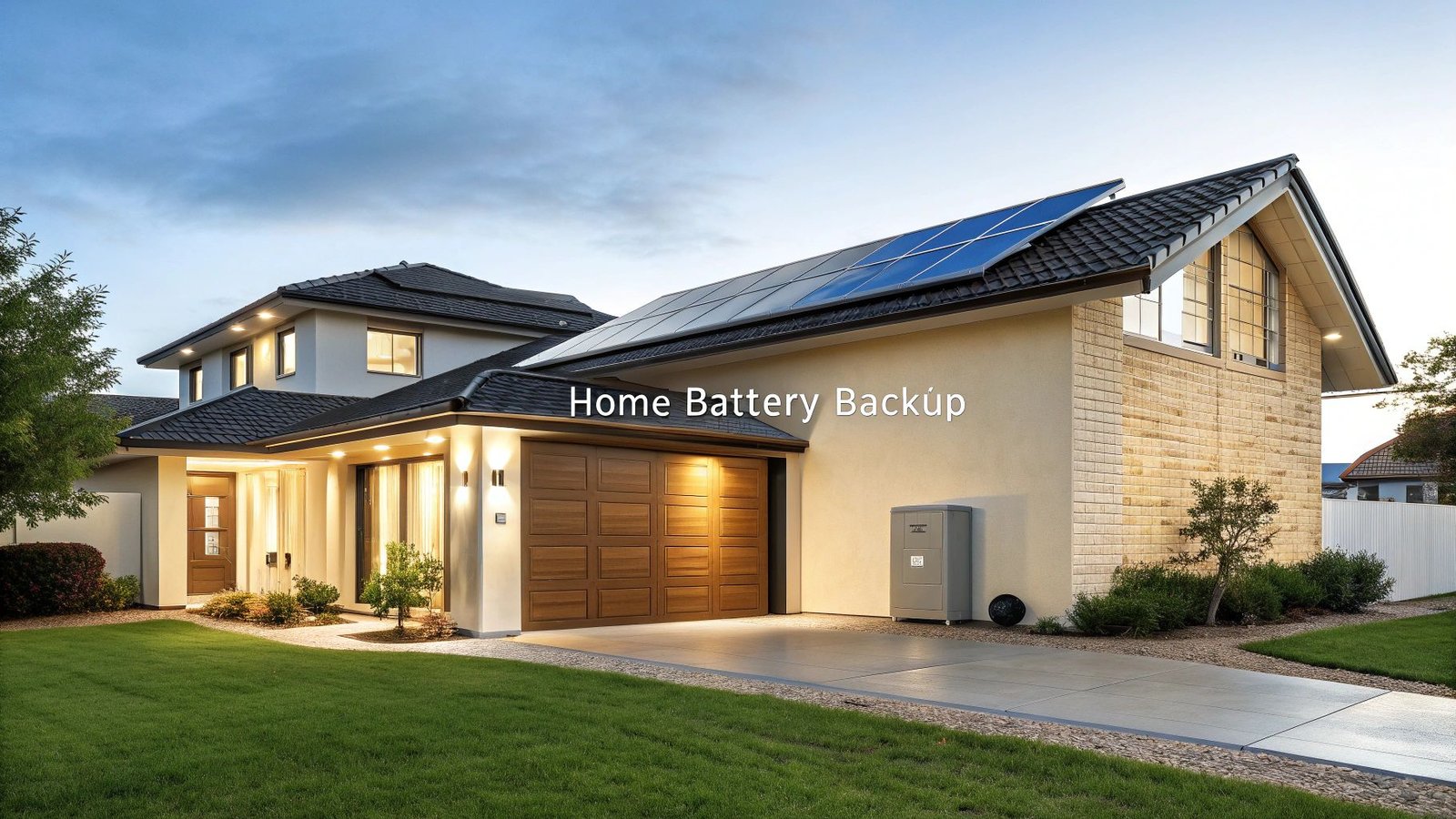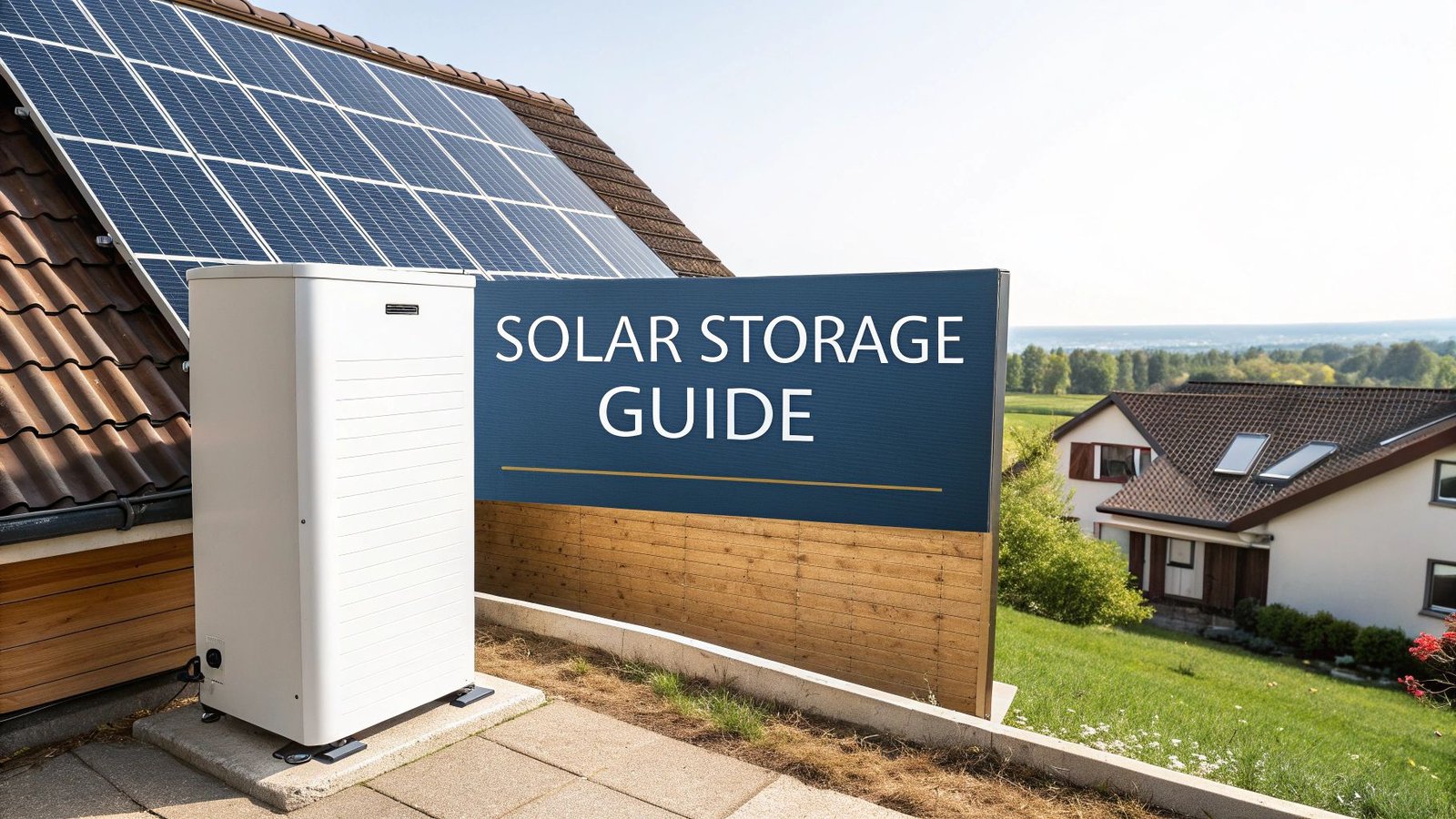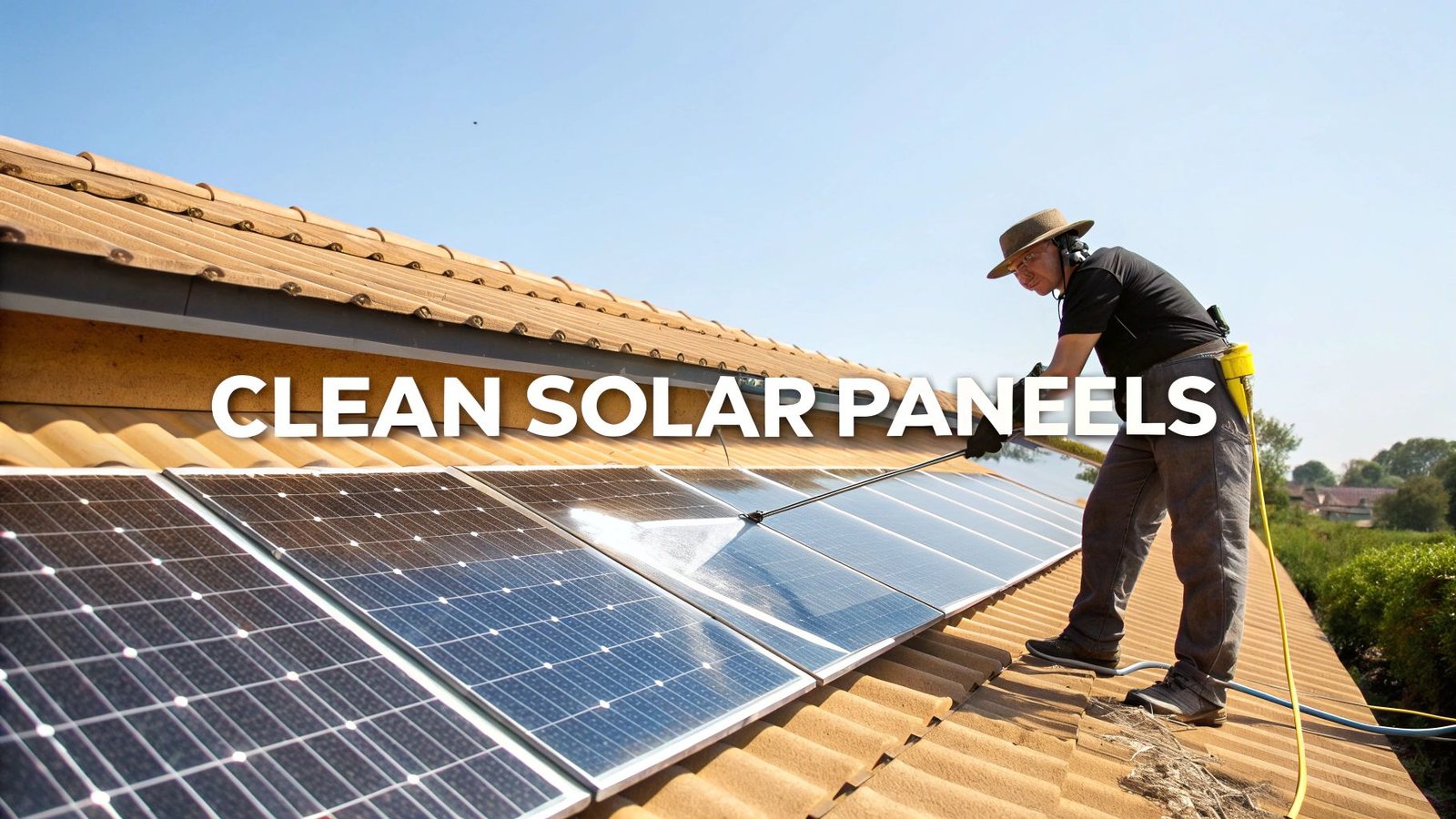If you're a homeowner looking for a solid power backup solution, the conversation has really shifted. The top contenders are now the Tesla Powerwall 3El Enphase IQ Battery 5Py el SonnenCore+. These aren't just big batteries; they offer a quiet, clean, and totally seamless alternative to the old-school generator. They keep your lights on during an outage and can even help chip away at your daily energy costs, especially if you have solar panels.
Why Home Battery Systems Are a Smart Investment
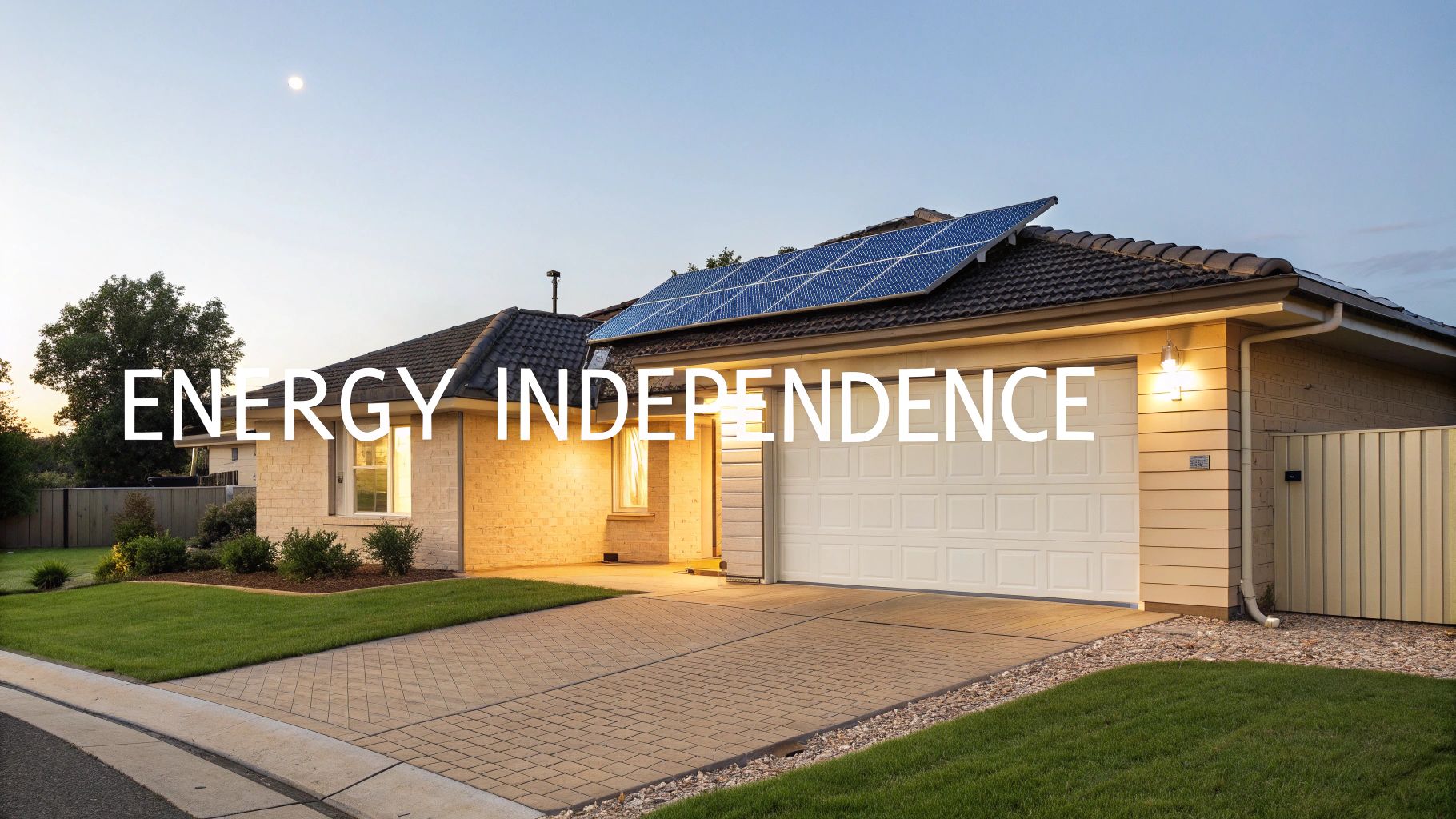
Let's face it, we rely on electricity for everything. That reliance makes us vulnerable when the power goes out. Between an aging grid, increasingly severe weather, and energy prices that seem to go in only one direction, having a reliable power source at home feels less like a luxury and more like a necessity. This is exactly where modern home battery systems come into play, and they do a lot more than just provide backup power.
A home battery is a dynamic part of your home's energy ecosystem, working 24/7 to deliver real benefits. It’s a world away from a noisy, fuel-guzzling generator that just sits there waiting for an emergency.
Beyond Emergency Power
At its heart, a battery system does one simple thing: it stores energy so you can use it later. But this simple function opens up a world of possibilities, especially for solar homeowners. On a sunny day, your panels might generate way more power than you're using. Without a battery, that extra energy just gets sent back to the grid, and you might not get much compensation for it.
A battery changes the game by capturing that surplus clean energy. When the sun sets or when utility rates jump during peak evening hours, your home can pull power from the battery instead of paying the utility company. This ability to "time-shift" your energy usage fundamentally changes your relationship with the grid.
graph TD
A[Solar Panels Generate Excess Power] --> B(Energy Sent to Battery for Storage);
B --> C{Decision Point};
C -->|Sun Sets or Peak Rates Start| D[Home Pulls Power from Battery];
C -->|Grid Power Outage| E[Battery Instantly Powers Home];
D --> F(Reduced Utility Bill);
E --> G(Uninterrupted Power);
- Energy Independence: You're no longer completely at the mercy of an unpredictable grid. You control your power.
- Cost Savings: By using your own stored solar energy when electricity is most expensive, you can see a real drop in your monthly bills.
- Seamless Backup: When an outage hits, the switch is instantaneous. You might not even notice the grid went down.
A home battery isn't just a passive backup device; it's an active financial asset. It provides protection from outages while actively working to lower your energy costs every day. It's a genuine investment in your home's resilience and financial future.
Comparing Batteries and Generators
When people think of backup power, the old debate between a battery and a generator often comes up. Generators have been the standard for years, but battery technology presents a pretty compelling modern alternative. The choice really boils down to how you value convenience, ongoing costs, and daily functionality.
| Característica | Home Battery System | Traditional Generator |
|---|---|---|
| Response Time | Instantaneous (milliseconds) | 5-20 seconds |
| Noise Level | Silent | Loud (similar to a lawnmower) |
| Fuel Source | Grid or Solar (Renewable) | Natural Gas, Propane, or Diesel |
| Maintenance | Virtually none | Regular (oil, spark plugs, etc.) |
| Daily Use | Yes (lowers utility bills) | No (emergency use only) |
Ultimately, choosing one of the best home battery backup systems is about securing peace of mind. It’s knowing that no matter what’s happening with the grid, your lights will stay on, your fridge will stay cold, and your daily life can continue without a hitch.
How to Figure Out Your Home Energy Backup Needs
Before you even start looking at different battery brands, the first step is a bit of homework on your own home. Picking the right home battery backup system is all about matching it to your actual needs. If you buy a system that’s too big, you're just throwing money away on capacity you won't use. Go too small, and you'll be left in the dark when it matters most.
This whole idea of energy independence is really catching on. The global market for battery backups was already around $10.5 billion in 2023 and is expected to more than double to $22.8 billion by 2032. That’s a steady growth of 8.9% each year, which tells you a lot about how many people are looking for reliable power.
graph TD
title[Global Home Battery Backup Market Growth ($ Billion)]
A[2023: $10.5B] --> B(CAGR: 8.9%);
B --> C[2032: $22.8B];
style A fill:#87CEEB
style C fill:#4682B4
Pinpoint Your Critical Loads
Let's be realistic: during a power outage, you probably don't need to run your entire house like normal. The real goal is to keep the essentials humming along. We call these your critical loads.
Think through what a real outage would look like for your family and make a list. What can you absolutely not live without?
- Refrigeration: Your fridge and freezer are non-negotiable to keep food from spoiling.
- Communication: The Wi-Fi router and modem are key for staying connected and getting updates.
- Medical Equipment: Any device that's crucial for health, like a CPAP machine, has to stay on.
- Lighting: A few lights in high-traffic areas like the kitchen or a bathroom make a huge difference.
- Comfort & Safety: This could be a small fan in hot weather, a well pump for water, or even a sump pump to prevent flooding.
I see this all the time—people try to back up everything. The smarter move is to focus on your true critical loads. It ensures you get a system that's both effective and affordable, powering what actually matters when the grid is down.
Calculate Your Daily Energy Use
Once you have that list, it's time to figure out how much power those devices actually use. This is measured in kilowatt-hours (kWh), the same unit you see on your utility bill and on battery spec sheets. To get this right, you'll need to calculate your home's electrical energy consumption for those specific items.
It's simpler than it sounds. For instance, a modern refrigerator typically uses between 1-2 kWh per day. Your internet setup might pull another 0.2 kWh. Adding these up gives you a baseline for your daily backup needs.
Here’s a quick example of what that math looks like:
| Appliance | Daily Consumption (kWh) |
|---|---|
| Refrigerator | 1.5 kWh |
| Wi-Fi Router & Modem | 0.2 kWh |
| Sump Pump (running intermittently) | 0.8 kWh |
| A few LED Lights (on for 4 hours) | 0.2 kWh |
| Total Daily Need | 2.7 kWh |
This quick tally shows that a battery with at least 3 kWh of usable capacity would get you through a full day without power for these essentials.
Get to Know the Key Battery Specs
Finally, there are two technical terms you absolutely need to understand before you buy: Profundidad de descarga (DoD) y eficacia de ida y vuelta.
Profundidad de descarga (DoD) is just the percentage of a battery's total capacity you can safely use without damaging it. If a battery is rated at 10 kWh but has a 90% DoD, it means you really only have 9 kWh of usable energy. A higher DoD is always better because you get to use more of what you paid for.
Round-trip efficiency tells you how much energy you get back out compared to what you put in. Think of it like a "tax" for storing energy. If you charge a battery with 10 kWh of electricity and it has 90% round-trip efficiency, you'll only be able to pull 9 kWh back out. This is a huge deal, especially if you're pairing your battery with solar panels. If you want to dive deeper into making your system as efficient as possible, our guide on how to store solar energy is a great place to start.
Comparing the Top Home Battery Backup Systems
Choosing the right home battery backup system isn't just about picking a brand. The real story is in the specs—the nitty-gritty details of performance, chemistry, and power delivery that determine how well a system will actually work for your home. Let's dig into the key players—Tesla Powerwall, Enphase IQ Battery, and SonnenCore+—and see what makes them tick.
The demand for these systems is booming. Valued at $2.82 billion in 2024, the global home energy storage market is on track to hit $6.89 billion by 2034. Lithium-ion batteries dominate, making up about 70% of the market, with the 10 to 20 kWh capacity range being the sweet spot for most homeowners.
Usable Capacity vs. Advertised Capacity
One of the first things to get straight is the difference between total and usable capacity. Think of it like a gas tank—there's always a little held in reserve to protect the system. The number you really care about is usable capacity, because that’s the actual energy you can tap into.
For instance, the Tesla Powerwall 3 offers 13.5 kWh of usable capacity. That’s 13.5 kilowatt-hours of real, accessible power to keep your home running when the grid goes down. This figure is everything, as it directly translates to how long you can keep the lights on and the fridge cold.
Continuous Power vs. Peak Power
Just as important as how long your battery lasts is how much it can run at once. That's where power output, measured in kilowatts (kW), comes in. You need to look at two numbers here.
- Continuous Power: This is the steady, consistent power the battery can provide for hours. It’s what runs your everyday essentials like lights, your router, and refrigerators without a hitch.
- Peak Power: This is a quick, powerful burst of energy the battery can push out for a few seconds. It’s crucial for starting up big-ticket items like an air conditioner or a well pump, which need a massive jolt of electricity to get their motors running.
A great example is the Enphase IQ Battery 5P, which delivers 3.84 kW of continuous power but can surge to 7.68 kW for 10 seconds. That high peak rating is perfect for homes with power-hungry appliances that need that initial kick.
The difference between continuous and peak power is what separates a partial backup from a true whole-home solution. A system might have enough continuous power for small devices, but without enough peak power, it won't be able to start your central AC on a hot day.
This chart breaks down the typical energy demands of essential appliances, giving you a clearer picture of what your battery needs to handle during an outage.
As you can see, some appliances like a refrigerator have a steady draw, while others like medical devices need a smaller but absolutely constant supply.
Battery Chemistry: LFP vs. NMC
The type of lithium-ion chemistry inside your battery is a big deal, impacting safety, lifespan, and performance. The two main players are Lithium Iron Phosphate (LFP) and Nickel Manganese Cobalt (NMC).
Lithium Iron Phosphate (LFP) is quickly becoming the gold standard for home batteries, and for good reason. LFP chemistry is incredibly stable, which makes it far less likely to overheat. It also boasts a much longer cycle life, meaning it can handle significantly more charge and discharge cycles before it starts to lose capacity. Both Sonnen and Enphase have gone all-in on LFP.
Níquel Manganeso Cobalto (NMC) was popular in earlier battery models because it has a higher energy density, allowing for a slightly smaller and lighter unit. While older Powerwalls used NMC, it’s telling that the latest features of the Tesla Powerwall 3 show a switch to the safer, more durable LFP chemistry. This industry-wide move toward LFP really highlights the focus on homeowner safety and long-term reliability.
Home Battery Backup System Feature Comparison
To bring it all together, let's put these systems side-by-side. The table below cuts through the noise and compares the specs that matter most, helping you see where each system really shines.
| System | Usable Capacity (kWh) | Continuous Power (kW) | Peak Power (kW) | Battery Chemistry | Warranty (Years/Cycles) | Lo mejor para |
|---|---|---|---|---|---|---|
| Tesla Powerwall 3 | 13.5 kWh | 11.5 kW | 30 kW | LFP | 10 Years / Unlimited Cycles | Whole-home backup with high power needs. |
| Enphase IQ Battery 5P | 5.0 kWh (Modular) | 3.84 kW | 7.68 kW | LFP | 15 Years / 6,000 Cycles | Homes needing a scalable, modular system. |
| SonnenCore+ | 10 kWh or 20 kWh | 4.8 kW | 8.6 kW | LFP | 10 Years / 10,000 Cycles | Long-term reliability and high cycle life. |
Looking at the data, the differentiators are clear. The Tesla Powerwall 3 is an absolute beast, pushing out an incredible 11.5 kW of continuous power. It’s designed to be a seamless, whole-home solution that can run pretty much everything you throw at it.
Enphase, on the other hand, is all about flexibility. The IQ Battery 5P's modular design means you can start with one 5 kWh unit and stack more later as your needs change or your budget allows.
Then there's SonnenCore+, which plays the long game. With a warranty that covers an impressive 10,000 cycles, it’s built for endurance and aimed at homeowners who prioritize longevity and lifetime value.
Ultimately, each of these systems is a strong contender, but the best one for you depends entirely on your home's unique power demands and what you want to achieve with your energy storage. By focusing on usable capacity, power ratings, and chemistry, you'll be able to make a confident choice that will keep you powered for years.
Choosing the Right Battery System for Your Lifestyle
https://www.youtube.com/embed/1N_ZsLrfUJM
Technical specs are a great place to start, but they rarely tell the whole story. The best home battery backup for you is the one that fits seamlessly into your life and helps you achieve your specific goals. It's really about matching the technology to your priorities, whether you're chasing total energy independence, demanding rock-solid safety during emergencies, or building a fully integrated smart home.
To narrow down the options, it helps to think about what kind of user you are. By figuring out which of these profiles sounds most like you, you can cut through the marketing noise and focus on the features that will actually make a difference.
The Solar Self-Sufficiency Enthusiast
For this homeowner, the mission is clear: use as little grid power as possible. You’ve already invested in solar panels, and now you want a battery that can intelligently capture and store every drop of sunshine, making your home a self-powered fortress.
Your ideal setup isn't just a backup device; it's the command center for your home's entire energy ecosystem. You'll want a system with advanced software that gives you granular control over how your energy is used.
Key features to look for include:
- Time-of-Use Optimization: The system should automatically charge from your solar panels (or the grid) when rates are lowest and then power your home when rates spike.
- Storm Watch Modes: This is a crucial feature that monitors local weather forecasts and proactively charges the battery to 100% before a potential storm hits.
- Detailed Monitoring: A top-notch mobile app is a must, giving you real-time data on your solar production, battery storage, and home consumption.
For the self-sufficiency enthusiast, the software is just as important as the hardware. A system that can intelligently manage energy flow transforms a battery from a simple storage tank into an active tool for maximizing your solar investment and minimizing your carbon footprint.
The Ultimate Emergency Preparedness Homeowner
If your number one concern is keeping your family safe and your home running through extended power outages, your focus shifts from clever software to raw power and capacity. You need a workhorse system that can handle anything you throw at it, from a summer blackout during a heatwave to a multi-day winter storm.
For this profile, you need to prioritize systems that offer:
- High Continuous and Peak Power: You need enough juice to run your essentials for days on end, plus the peak power to start up demanding appliances like a central air conditioner or a well pump.
- Large and Scalable Capacity: A single battery probably won't cut it. Look for modular systems that let you easily stack multiple units to reach 20 kWh, 30 kWh, or even more total storage.
- Durable Chemistry: Lithium Iron Phosphate (LFP) battery chemistry is the gold standard here, known for its superior safety and long-term reliability, especially under heavy use.
Our detailed guide on home backup power solutions can help you dig deeper into building a resilient energy setup that you can truly depend on.
The Tech-Savvy Smart Home Integrator
For the tech-forward homeowner, a battery is the next logical piece of the connected-home puzzle. You want a system that communicates flawlessly with your other smart devices—from your thermostat to your EV charger—to create a home that’s not just smart, but truly automated and efficient.
The residential battery backup market is evolving quickly to meet these demands, with an estimated valuation of USD 14.35 billion in 2025 projected to grow to USD 47.12 billion by 2032. This incredible growth is fueled by advancements like AI-driven energy management. For instance, some of the newest systems can intelligently coordinate with third-party devices to optimize your entire household's energy use.
Features to Prioritize:
| Característica | Why It Matters for a Smart Home |
|---|---|
| Open API or Integrations | This is key for seamless communication with platforms like Alexa, Google Home, or Home Assistant. |
| EV Charger Integration | Enables smart charging, which can automatically use excess solar power to charge your electric vehicle for free. |
| Load Control Capabilities | Lets the system automatically shut down non-essential circuits during an outage to preserve power for what truly matters. |
By figuring out which of these profiles best fits your goals, you can ensure your investment doesn't just give you backup power, but actively enhances your lifestyle in the ways that are most important to you.
Putting a Price on Power: What Your Home Battery System Will Really Cost
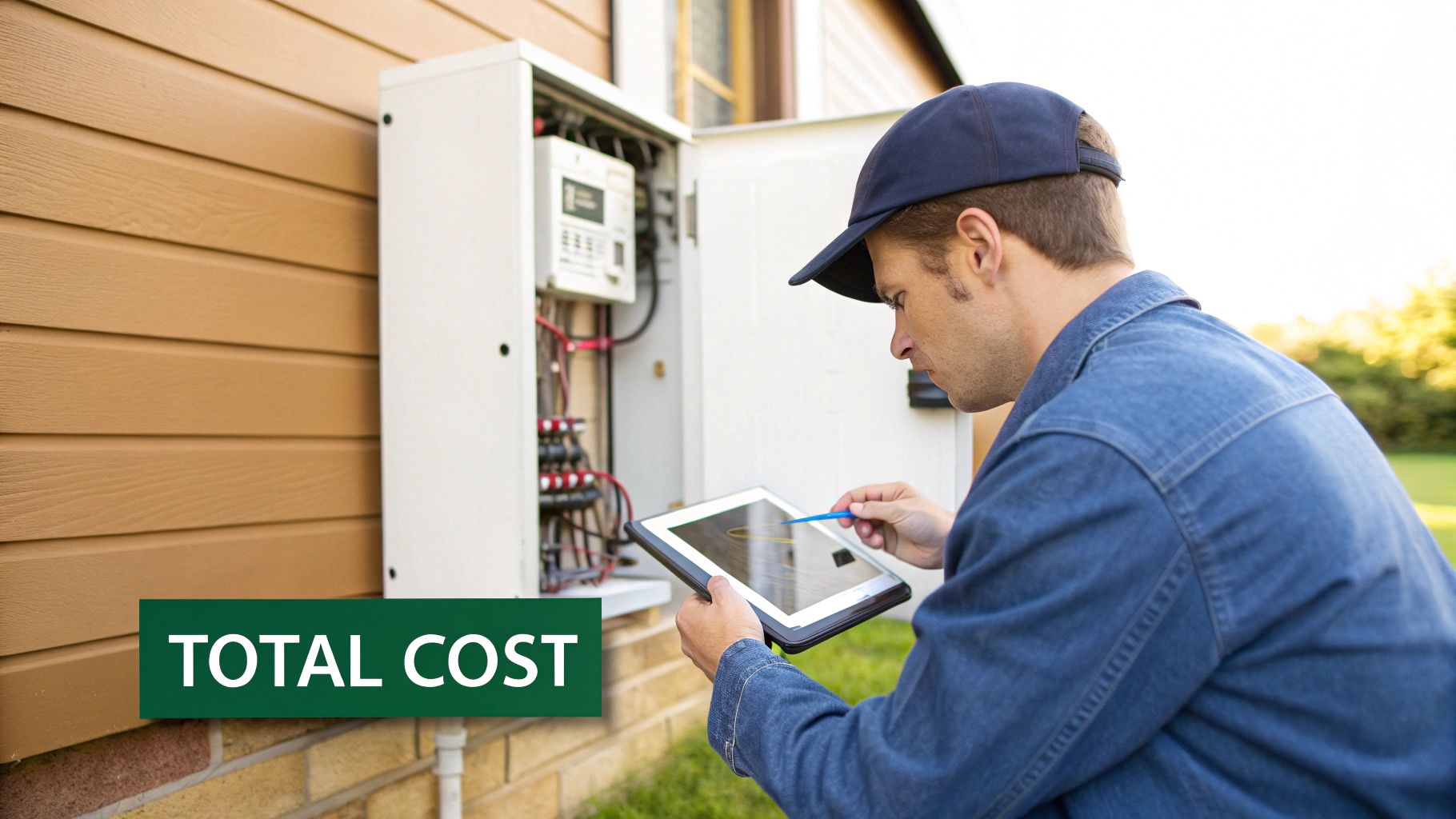
When you start shopping for a home battery, it's easy to get fixated on the price of the battery itself. But that's only one piece of the puzzle. The real, all-in cost for a professionally installed system typically lands somewhere between $10,000 and over $20,000. That number can feel like a jump, but it accounts for everything needed to get you powered up safely and reliably.
So, what are you actually paying for? The total investment covers the battery unit, a crucial piece of hardware called an inverter (which turns the battery's DC power into the AC power your home uses), plus all the mounting gear, wiring, and professional labor. Getting a handle on these numbers upfront helps you budget properly and avoids any sticker shock later on.
Breaking Down the Total Investment
A home battery installation isn't just about hanging a box on the wall. It's a full-fledged electrical project, and the final price reflects that. Skipping corners isn't an option, as a proper installation is key to both performance and safety.
Here's a quick look at where the money goes:
- The Battery Unit: This is your biggest ticket item, the heart of your energy storage.
- Inverter and Hardware: Think of the inverter as the system's brain. This category also includes transfer switches and other electrical components needed to integrate with your home.
- Installation Labor: You're paying for a certified electrician's expertise, which usually takes one to two full days of work. This isn't a DIY project.
- Permitting and Fees: Your local city or county will need to sign off on the project, and those permits and inspections come with fees.
The total cost is more than a sticker price; it's an all-in investment in your home's energy infrastructure. Factoring in labor, permits, and supporting hardware from the start provides a realistic financial picture.
To give you a better idea, here's how the costs often break down.

Factors That Can Drive Your Final Cost Up (or Down)
No two installations are exactly the same, and a few key variables can really swing the final price. The biggest wild card is often your home's existing electrical panel. If you have an older panel or one that’s already maxed out, you’ll likely need an upgrade to handle the extra load from the battery. This is a common requirement, and you can learn more about what an electrical panel upgrade for solar and battery integration involves.
The physical installation itself matters, too. A simple setup in an accessible garage will be more affordable than a complex job that requires running conduit across the house or trenching in the yard. On top of that, local labor rates and permitting costs vary from one town to the next, all of which get factored into your final quote.
Don't Forget About Financial Incentives
Here’s the good news: you probably won't have to foot the entire bill yourself. There are some fantastic financial incentives out there designed to make home energy storage much more affordable. When you stack them up, they can shave thousands off your initial investment.
The most powerful one is the Crédito fiscal federal a la inversión solar (ITC). This lets you claim 30% of the total system cost—including the hardware and the installation—as a credit on your federal taxes. The main requirement is that the battery must be charged by an on-site renewable energy source, like solar panels.
But it doesn't stop there. Many states, local governments, and even utility companies have their own perks.
| Tipo de incentivo | Descripción | Typical Value |
|---|---|---|
| State Rebates | These are direct cash-back payments you get for installing a battery system. | $1,000 – $5,000+ |
| Utility Programs | Some utilities will actually pay you to let them tap into your battery's power during peak demand hours. | Varies by program |
| Property Tax Exemptions | A few states will exempt the value your battery system adds to your home from your property taxes. | Ongoing savings |
By taking advantage of these programs, you can make a huge dent in the upfront cost. It makes achieving energy independence not just possible, but practical.
Still Have Questions About Home Batteries? Let's Clear Them Up.
Jumping into home energy storage can feel like a big step, and it's natural to have questions. You're making a major investment, so concerns about performance, what works with your current setup, and how it all plays out day-to-day are completely normal.
Let's walk through some of the most common questions we hear from homeowners. The goal here is to cut through the noise and give you straight answers so you can feel confident about your decision.
How Long Will a Home Battery Actually Last During an Outage?
There's no single answer to this, because it all comes down to two things: your battery's usable capacity (measured in kWh) and what you're trying to run. Think of it like a gas tank in your car—how far you can go depends on the size of the tank and how hard you're pushing the engine.
A typical 13.5 kWh battery, for instance, can easily keep essentials like your fridge, lights, and Wi-Fi running for a solid 12 to 24 hours.
But the second you fire up a power-hungry appliance like your central air conditioner, that runtime is going to drop, and fast. The smart move is to figure out your "must-have" loads first and size your system to cover those for the amount of time you want. That way, you know you've got power for what really matters.
I Already Have Solar Panels. Can I Add a Battery?
Yes, absolutely. In most situations, you can add a battery to an existing solar panel system. This process is called AC-coupling.
Essentially, the new battery comes with its own inverter and connects right into your home's main electrical panel. This allows it to charge up using your solar power while operating independently from your original solar inverter. It’s a pretty standard procedure, but you'll definitely want a certified installer to handle it to make sure everything is compatible and wired up safely.
The ability to retrofit a battery to an existing solar system is a game-changer. It means you can boost your home's resilience and get the full financial benefit of solar storage without having to rip out your current setup and start over.
What's the Real Difference Between LFP and NMC Batteries?
These acronyms get thrown around a lot, and they refer to the two main chemistries used in home batteries. The choice between them actually has a big impact on safety and longevity.
- LFP (Lithium Iron Phosphate): This is what the industry is moving toward, and for good reason. LFP batteries are known for being incredibly safe because they're far less likely to overheat. They also last much, much longer, handling thousands more charge and discharge cycles than NMC.
- NMC (Nickel Manganese Cobalt): NMC batteries can pack a bit more power into a smaller space, making them slightly more energy-dense. The trade-off is a shorter operational lifespan and a lower safety threshold when it comes to heat.
For a long-term investment in your home, the stability and durability of LFP chemistry make it the clear winner.
If I Have a Generator, Do I Still Need a Battery?
A generator and a battery both provide backup power, but they do it in completely different ways and solve different problems. A generator is a gas-guzzling machine. It's loud, needs maintenance, and is really only there for emergencies.
A home battery, on the other hand, gives you silent, instant, and clean power. The biggest difference is that a battery works with your solar panels every single day, letting you store and use your own free energy to cut down your utility bills.
Most homeowners prefer the seamless, quiet operation of a battery. However, if you have critical power needs or live somewhere with frequent, multi-day outages, some people opt for both to have the ultimate redundant system.
Ready to take control of your home's power and protect your family from outages? The team at Energía radiante designs and installs home battery systems tailored to your home and your needs. We take care of everything from the initial design to permitting and professional installation, making the switch to reliable, clean energy simple. Contact us today for a free consultation!

